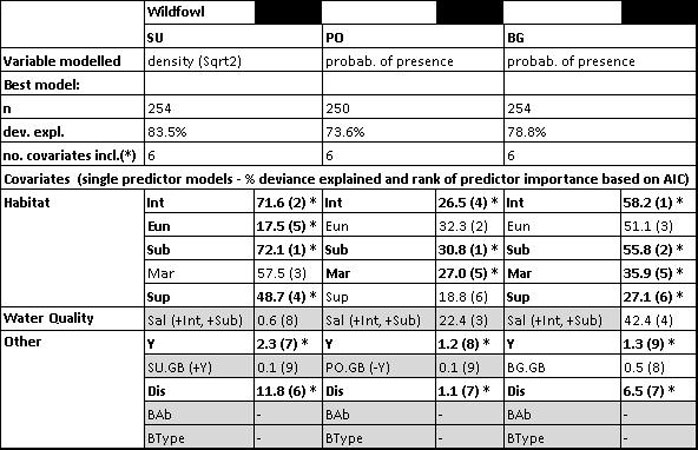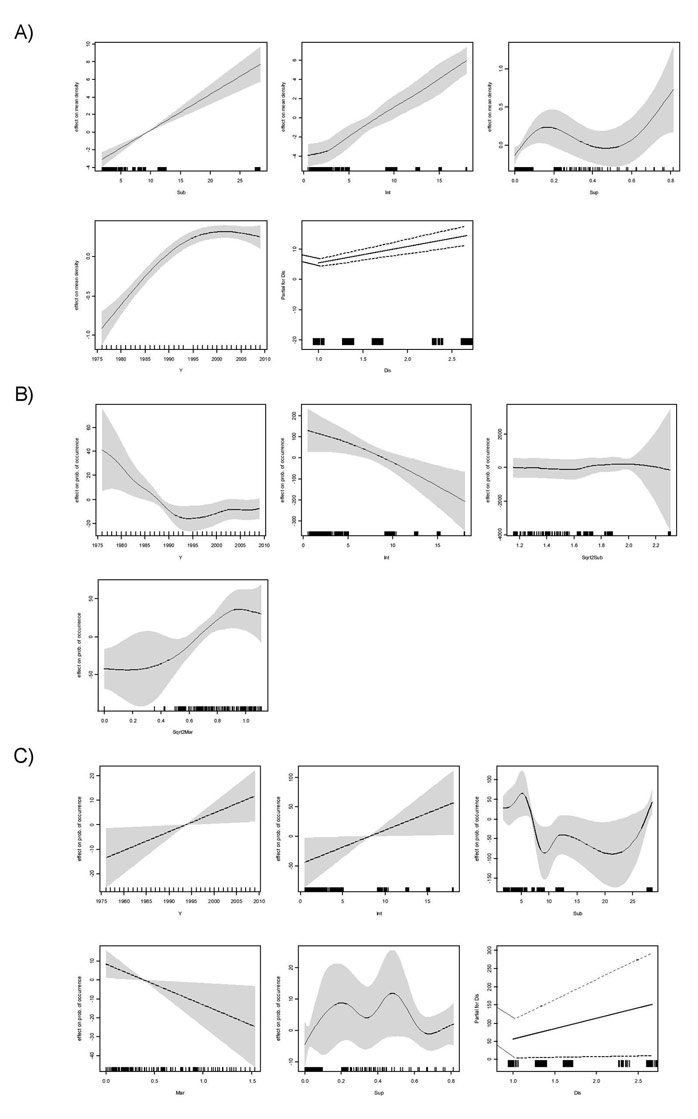

Determinants of bird habitat use in TIDE estuaries
Table of content
- 1. SUMMARY
- 2. INTRODUCTION
- 3. STRUCTURE OF THE REPORT
- 4. DATA USED
- 5. GENERAL CHARACTERISTICS OF BIRD ASSEMBLAGES IN TIDE ESTUARIES
- 6. BIRD ASSEMBLAGES DISTRIBUTION AND RELATIONSHIP WITH ENVIRONMENTAL VARIABLES
- 6a. Humber
- 6b. Weser
- 6c. Elbe
- 7. SPECIES DISTRIBUTION MODELS
- 7a. Dunlin
- 7b. Redshank, Golden Plover and Bar-tailed Godwit
- 7c. Shelduck, Pochard and Brent Goose
- 8. DISCUSSION
- 9. CONCLUSIONS
- 9a. Analysis Conclusions
- 9b. Management Recommendations
- 9c. Recommendations for Future Studies
- 10. REFERENCES
- 11. APPENDIX 1
- 12. APPENDIX 2
- 13. APPENDIX 3
- 14. APPENDIX 4
7c. Shelduck, Pochard and Brent Goose
The density distribution of Shelduck, Pochard and Brent Goose was analysed in the Humber estuary. A summary of the resulting models obtained for these species is reported in Table 7 and the shape of the effect of each selected continuous predictor variable on the model response is shown in Figure 9.
Shelduck is a large duck which is present throughout much of the Humber estuary, where it feeds on mudflats. Six environmental variables have been selected in the final model as best predictors of its density distribution in the estuarine areas, explaining 83% of the density data variability. The most important predictors of the density of this species are the subtidal and the intertidal area, both variables showing an almost linear positive relationship with this species. The species density is also expected to increase with the supratidal area in the estuarine sectors, particularly with areas >0.5 km2. However, the type of intertidal habitat is also relevant in affecting the species distribution, with higher density expected where littoral mud substratum dominates. Similarly to that observed for other species, an increase in Shelduck density is predicted in sectors where a higher disturbance index is measured. However, it is emphasised that rather than this being a reflection of a real preference of the species for more disturbed areas, this result is likely to be an artefact of the analysis, due to the possible inadequacy of the measured index as a proxy for disturbance (see Discussion for a detailed explanation). A relevant effect of temporal trends (measured by year) on the local estuarine population is also present, although this variable, together with the disturbance index, are the least important predictors of Shelduck density among those considered in the analysis.
Pochard is a largely freshwater duck that can be found in the estuary during winter, although its frequency of occurrence in the studied dataset is relatively low (23%), due to the distribution of the species mostly in the upper estuary sectors (oligohaline and upper mesohaline areas). The probability of occurrence was modelled for the species in the Humber and six environmental variables have been selected in the final model as best predictors of its distribution in the estuarine areas, explaining 74% of the data variability. Although most of the habitat areas (except for supralittoral area) are included as important predictors of the occurrence of the species in the estuary, it is the relationship with intertidal and marsh areas that show the most marked patterns, with a higher probability of finding Pochard in sectors where the intertidal area is <10 km2, but there is a wider marsh area (>0.84 km2) compared to other sectors. The type of intertidal habitat also seems to be a relevant predictor of the species occurrence, although the relationship with this factor is not clear, due to the similar contribution of the different types to the probability of presence but with a wider variability of the data where mixed substrata dominated by littoral mud occur. Also for this species, the potential degree of disturbance index (in this case showing a negative linear effect on the species, although the rate of decrease of the probability of occurrence is very low) and the effect of temporal trends (measured by year) on the local estuarine population is present, these variables being the least important predictors of the species presence among those considered in the analysis.
Brent Goose is a migrating species found during winter months in estuaries and saltmarshes, grazing upon surface plants and green algae on mudflats. For this species, the probability of occurrence was modelled in the Humber due to the limited frequency of presence (44%). Six environmental variables have been selected in the final model as best predictors of its distribution in the estuarine areas, explaining 79% of the data variability. All the variables accounting for habitats area within the sectors are included as predictors of the occurrence of the species in the estuary, with intertidal area being the most important one. In particular, based on the obtained model, a higher probability of occurrence of the species is expected where the intertidal area is maximised in the sector (in particular when >10 km2), in combination with small marsh area (<0.5 km2), intermediate supralittoral area (between 0.1 and 0.6 km2) and either smaller (<7 km2) or larger (>27 km2) subtidal area. An increase in Brent Goose occurrence is also predicted in sectors where a higher disturbance index is measured, but, as highlighted before, this is likely to be an artefact of the analysis rather than being a reflection of a real preference of the species for more disturbed areas (see Discussion for a detailed explanation). A relevant effect of temporal trends (measured by year) on the local estuarine population is also present, although, as observed for other species, this variable, together with the disturbance index, are the least important predictors of the species presence among those considered in the analysis.
| Species distribution models Multiple regression models applied to Dunlin (in the three estuaries) and to Golden Plover, Redshank, Bar-Tailed Godwit, Shelduck, Pochard and Brent-Goose (in the Humber) allowed the identification of the main environmental determinants of their habitat use within the studied TIDE estuaries. In general, no single factor is responsible for the species distribution, although some factors may show a higher importance than others in affecting it. Overall, although relevant to some species, temporal changes have a secondary effect on the species distribution within the estuaries compared to spatial factors. The area of intertidal and shallow subtidal habitats (but also marshland) is particularly important in affecting Dunlin density distribution. In the Weser and Humber higher density of the species is predicted where wider more extensive habitats occur, whereas in the Elbe an opposite relationship is observed. In the Elbe, salinity is also a relevant factor in predicting the distribution of this species, with higher density and occurrence expected in oligohaline and mesohaline zones. In this estuary, the presence of the species is also affected by nutrients, with lower occurrence where high phosphate concentration and intermediate ammonium concentrations are present. In this estuary, wider and more extensive intertidal habitats are also the most important determinant of higher density of two other wader species feeding on mudflats, Redshank and Bar-tailed Godwit. For both species, this condition is usually also associated with the presence of littoral sands and to either higher (for Redshank) or lower (for Bar-tailed Godwit) density of benthic invertebrates in the intertidal. In turn, Golden Plover density in the Humber is increased by the presence of smaller subtidal areas but also of wider marsh (and also intertidal) areas, combined to sandy substrata in the intertidal. The extension of intertidal and marsh habitats are also generally important in affecting the distribution of the studied wildfowl species in the Humber, although different relationships have been observed. Higher density of Shelduck (a species feeding on mudflats) is predicted in larger sectors where wider subtidal, intertidal and supralittoral habitats occur, in combination with more muddy substrata in the intertidal and relatively higher disturbance. Brent Goose (a species grazing on mudflats) is also more likely to occur where wider intertidal habitats are present in the estuary, in association with smaller marsh areas and intermediate areas of the supralittoral habitat. In turn, Pochard (a freshwater duck) is more likely to occur where wider marsh areas are present together with smaller intertidal habitat. |
Important to know
Reports / Measures / Tools
| Report: | Management measures analysis and comparison |
|---|
Management issues
How can management targets and monitoring strategies be set for waterbirds in compensatory areas?What environmental factors should be considered in the design of a compensation scheme for waterbirds and their habitats?
What environmental variables are most important in determining minimizing or basic compensatory requirements for waterbirds?
What is important in establishing a zonation for estuaries?
What tools and guidance are available to minimise and mitigate disturbance to waterbirds?

